Mercedes W221 S-Class 2006 – 2013
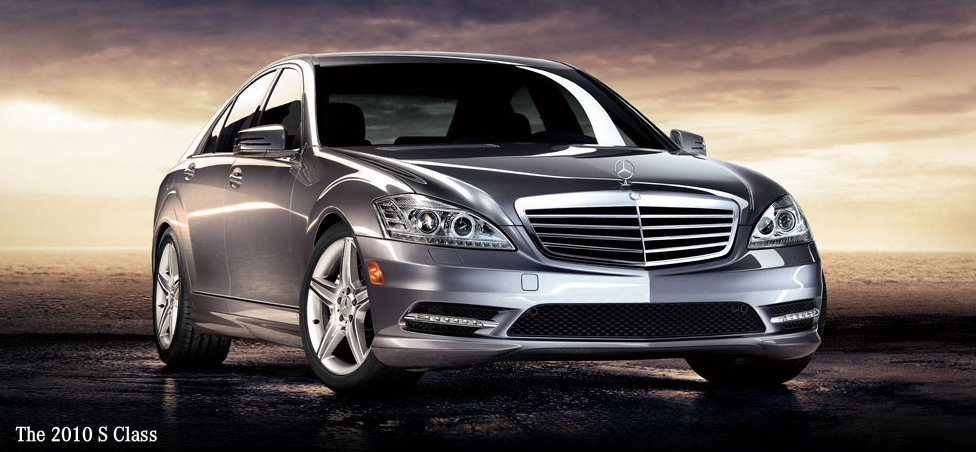

The Mercedes-Benz W221 is a chassis code of S-Class, the successor of Mercedes-Benz W220. The vehicle was unveiled in 2005 Frankfurt Motor Show.
Styling
The W221 S-Class’ exterior styling is distinctly different to the W220. The rear styling is similar to the E65 BMW 7 Series, and also the Mercedes-Benz Maybach – the larger saloon from Daimler AG’s flagship brand, which was presented to public in 1997.
Inside, the W221’s interior is also significantly different from the preceding model. The interior features an instrument cluster shroud that also contains the navigation screen, with silver effect air vents below, and a square, analog clock within the vents.
Below the vents are metal tab switches with a black field behind them, to control the HVAC system.
On the center console, a metal control wheel for the COMAND system sits above a piece of wood, surrounded by metal buttons.
Throughout the interior, many buttons are metal, with black fields above them denoting the switches’ function.
The W221 is slightly larger in all dimensions than the W220, with a longer wheelbase and more interior room.
Models
S 320 CDI BlueEFFICIENCY (2008-2009)
It is a replacement of S 320 CDI with improved fuel efficiency. Changes include on-demand electric hydraulic power steering pump, standstill decoupling for the 7G-TRONIC transmission, 17-inch light-alloy wheels with reduced rolling resistance tyres.
Germany model has MSRP of (incl. VAT) for short wheelbase version, €78,718.50 (incl. VAT) for long-wheelbase version.
S 400 HYBRID (2009-)
The vehicle was originally announced under the name S 400 BlueHYBRID. The vehicle was unveiled in 2009 Chicago Auto Show.
It is a mild hybrid with the lithium ion battery was supplied by Continental AG. The cells were provided by Johnson Controls-Saft.
Production vehicle was sold as S 400 HYBRID. US models went on sale in August 2009, but was delivered to dealers in 2009-10. Japan models went on sale in October 2009.
ESF 2009 (2009)
It is a safety research vehicle based on S 400 HYBRID, but with braking bag, Interactive Vehicle Communication. The vehicle was unveiled in Enhanced Safety of Vehicles (ESV) Conference in Stuttgart.
S 420 CDI (2006-)
The vehicle were delivered beginning in December 2006, with MSRP of short-wheelbase model at (net price ) and the long-wheelbase model at (net price ).
S 600 Guard (2006-)
It is an armoured vehicle with European B6/B7 resistance level. It resists military-standard small-arms projectiles and provides protection against fragments from hand grenades and other explosive charges.
Additional safety features include run-flat tyres, 90L self-sealing fuel tank and a fire-extinguishing system.
Other features include Michelin PAX 245-700 R470 AC tires, 90L fuel tank, optional emergency fresh-air system, pneumatic emergency control system for the power windows (operates independently of the on-board electronics), emergency boot opening facility, optional Panic Alarm System, rear camera, heated front windscreen and heated front windows, adjustable doorhold system for all four doors, rear doors that are pulled shut automatically over the last few millimetres, rear electric roller blinds.
The vehicle has top speed of 210 km/h (130 mph), with GVW of 4,200 kg (9,300 lb).
S 600 Guard Pullman (2008-)
It was based on the Mercedes Benz S 600 L Guard, but in limousine form with an extra-long wheelbase. It includes a rear entrance with increased headroom, 4 seats behind driver partition.
Other features included reinforcement of the links between the suspension components and the bodyshell, specifically targeted modification of the suspension components themselves, an additional brace (strut tower brace) between the front suspension struts, two additional steel springs at the rear to complement the air suspension, larger twin-calliper front brake discs.
The vehicles were delivered beginning in late 2008. The production launch marked the 80th anniversary of the Mercedes-Benz special-protection unit.
S 63 AMG, S 65 AMG
S 63 AMG includes Mercedes-Benz M156 engine rated 525 PS (386 kW; 518 hp) and 465 pound-feet 630 N·m (465 ft·lbf).
S 65 AMG includes Mercedes-Benz M275 engine rated 612 PS (450 kW; 604 hp) and 1,000 N·m (738 ft·lbf), restyled front and rear bumpers and rocker panels, larger wheels, brakes, and tires, four exhaust pipes, modified and reprogrammed suspension for sport biased handling, and various interior changes.
2009 version
The engines had reduced fuel consumption and CO2 emissions by up to 3%. Styling changes include arrow-shaped radiator grille, AMG-specific daytime running lights, two transverse air outlets on each side, “6.3 AMG” or “V12 Biturbo” lettering on the front wings, redesigned exterior mirrors, 52-LED tail lights.
Active Body Control provides crosswind stabilisation as standard equipment. Torque Vectoring Brake is added.
Interior include PASSION leather upholstery, AMG-specific analogue clock featuring an IWC design.

Optional accessories include:
- AMG 20-inch forged wheels with 255/35R20 front and 275/30R20 rear tyres
- AMG trim elements in carbon fibre/piano lacquer
- AMG floor mats
The vehicles went on sale in June 2009, with S 65 AMG available in long-wheelbase version only. The vehicles were unveiled in 2009 Shanghai motor show.
Concepts
S 300 BLUETEC Hybrid (2007)
It is a concept vehicle. It included a 2.2L 4-cylinder diesel engine with urea injection and electric motor with combined rating of 224 PS (165 kW; 221 hp) and 560 N·m (410 ft·lbf), with fuel consumption of 5.4 litres of diesel per 100 kilometres.
The vehicle was unveiled in 2007 Frankfurt Motor Show. The car was estimated to go on sale in Europe in 2010.
S 400 BLUETEC Hybrid (2007)
It included V6 BLUETEC diesel engine and a electric motor with combined ratings of 265 bhp (198 kW) and 465 lb·ft (630 N·m). The vehicle was unveiled in 2007 LA Motor Show.
Mercedes-Benz Concept Ocean Drive (2007)
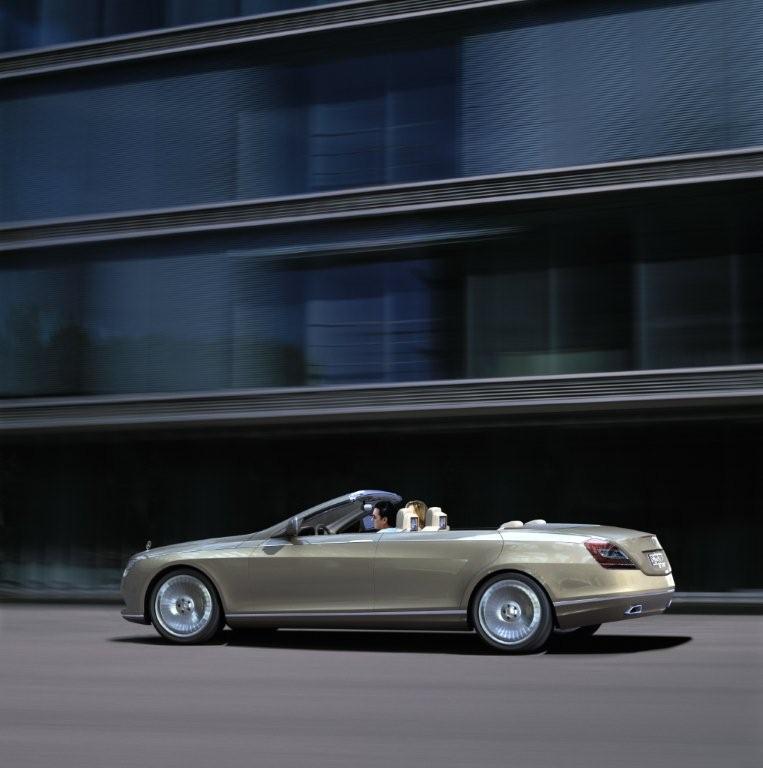
It is a concept vehicle based on long wheelbase version of S 600, but with two-tone yarn fabric roof.
The vehicle features an oversized grille, redesigned LED headlights and restyled trunk, LED head and tail lamps, a revised air dam, restyled flanks without the wheelhouse bulges, door handles that fit flush into the body, AIRSCARF neck-level heating system, on all 4 seats.
The car also contains pillarless windows that provide an unobstructed view for occupants when the large soft top is down.
Other features include aluminum wheels with 275/35ZR21 tires. The vehicle was unveiled in 2007 NAIAS.
S 500 Plug-in HYBRID (2009)
It is a plug-in hybrid vehicle. It included 3.5L V6 engine, hybrid module rated 60 PS (44 kW; 59 hp) and 250 Nm (180 lb/ft), lithium-ion battery rated over 10 kWh, 30 km electric-only driving range.
The vehicle was unveiled in 2009 Frankfurt Motor Show.

Be ahead: the new Mercedes-Benz S-Class – Superlative in design and technology
Generation-change at the pinnacle of automotive engineering: Mercedes-Benz presents the new S-Class.
The new luxury saloon will be appearing in the showrooms of company-owned outlets and authorised dealerships as of autumn 2005.


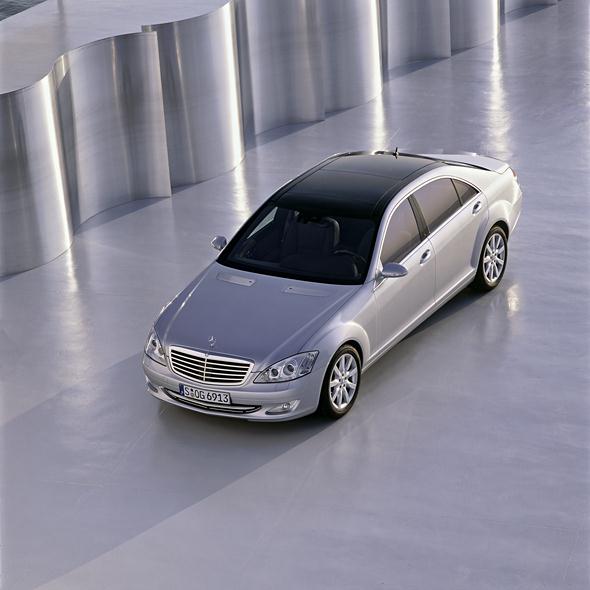



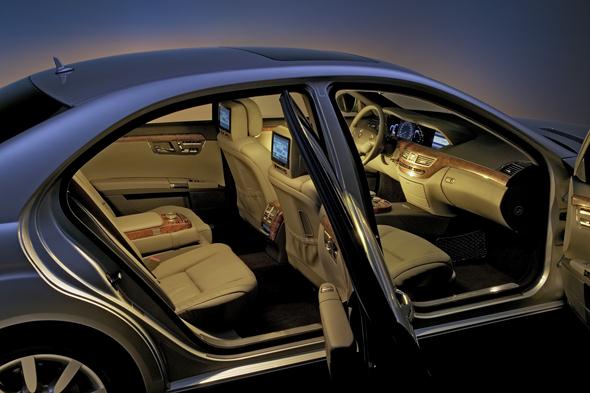




The new Mercedes-Benz S-Class at a glance
S 500: 285 kW/388 hp
S 320 CDI: 170 kW/231 hp (from first quarter 2006)
S 600: 380 kW/ 517 hp (from first quarter 2006)
Vehicle width: 1871 mm = + 16 mm
Vehicle height: 1473 mm = + 29 mm
Wheelbase: 3035/3165 mm = +70/80 mm
- ADAPTIVE BRAKE with additional functions
- Adaptive brake light
- Brake Assist PLUS with radar sensors
- COMAND with and COMAND controller
- Crash-responsive high-comfort head restraints
- DISTRONIC PLUS
- Electric parking brake
- Dynamic multicontour seat with new massage function
- Night view assist based on infra-red technology
- Panoramic sliding roof (for long-wheelbase version)
- Second-generation PRE-SAFE®
- Reversing camera
2009 facelift
The revised 2009 S-Class was announced on Apr 08, 2009 at Stuttgart. The minor model update includes minor cosmetic changes and several new features:
- Adaptive Highbeam Assist – detects vehicles with their lights on which are travelling towards or ahead of the car in which the system is fitted and controls the headlamps to ensure the largest possible range without dazzling other drivers.
- Blind spot monitor
- Lane Keeping Assist – detects road markings and senses if the driver is inadvertently straying out of the lane. If so, the driver is warned by short vibrations of the steering wheel. This system can also distinguish between intentional (for example, overtaking or merging) and unintentional lane departures, reducing the number of false alarms.
- Speed Limit Assist – identifies speed limit signs in passing and shows the relevant speed limit in the central display. It is standard for S 600.
- Attention Assist – continuously monitors more than 70 different parameters to detect driver fatigue and tiredness. Once the system detects behaviour that typically indicates the onset of drowsiness, a warning signal is sounded and “ATTENTION ASSIST. Break!” appears in the instrument cluster. It is not standard on S 400 HYBRID.
- Active Body Control (ABC) crosswind compensation – uses the sensors of the Electronic Stability Program (ESP) to vary the wheel load distribution via the ABC spring struts, depending on the direction and intensity of the crosswind, in order to reduce the adverse effects of crosswinds. This is standard on the S 600.
- Torque Vectoring Brake – brakes the inside rear wheel during cornering to enhance handling and safety by reducing understeer.
The updated models went on sale in June 2009. Early models include S 350 CDI BlueEFFICIENCY, S 450 CDI, S 350, S 400 HYBRID, S 450, S 500, S 600.
The world’s most powerful series-production car: The new S 65 AMG: in a class of its own
Exclusivity and dynamism in a wholly new dimension: the new Mercedes-Benz S 65 AMG in a nutshell.
The compelling top-of-the-line model of the brand new S-Class delivers 450 kW/612 hp and reaches peak torque of 1000 Nm – more than any other vehicle in this segment.
The use of the new, innovative AMG high-performance composite brakes with twin sliding callipers at the front further illustrates the unique technological prowess of the powerful AMG Saloon.
The standard specification of the new S 65 AMG includes a new AMG sports suspension based on Active Body Control, the unmistakable AMG bodystyling, multi-piece 19-inch AMG light-alloy wheels, DIRECT SELECT gearshift with AMG steering-wheel gearshift paddles as well as the new AMG main menu with RACETIMER.
The powerful AMG Saloon stands self-confidently ahead of the competition, testimony to the outstanding role of Mercedes-AMG GmbH in developing extraordinary vehicles and powerful drive systems.



S 400 HYBRID: CO2 champion with efficient hybrid drive





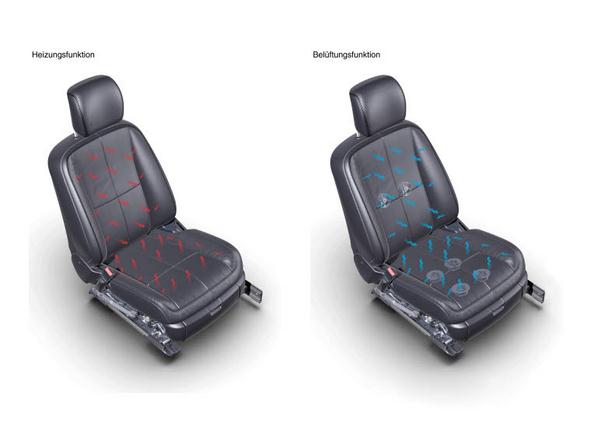
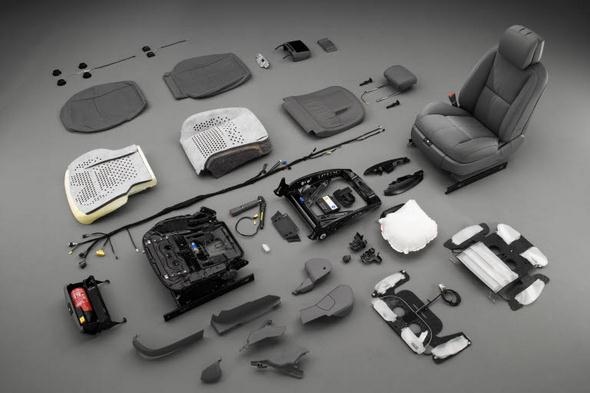




- 1. In the first stage all the wiring is colour-coded to eliminate confusion, and all components are marked with safety instructions. This makes the regular quality checks easier to carry out.
- 2. The second stage comprises comprehensive contact protection for the entire system by means of generous insulation and newly developed, dedicated connectors.
- 3. As part of the third stage, the world’s first lithium-ion battery to be used in a series-production model has been given a whole package of carefully coordinated safety measures. This innovative battery is accommodated in a high-strength steel housing, and also secured in place. Bedding the battery cells in a special gel effectively dampens any jolts and knocks. There is also a blow-offvent with a rupture disc and a separate cooling circuit. An internal electronic controller continuously monitors safety and immediately signals any malfunctions.
- 4. The fourth stage of the safety concept includes separation of the battery terminals, individual safety-wiring for all high-voltage components and continuous monitoring by multiple interlock switches. This means that all high-voltage components are connected by an electric loop. In the event of a malfunction the high-voltage system is automatically switched off.
- 5. As soon as the ignition is switched to “off” or if there is a fault, circuit breakers are activated in the fifth stage so that the high-voltage components are de-energized. The battery remains charged so that the engine can be re-started at any time.
- 6. During an accident, the high-voltage system is completely switched off within fractions of a second (stage six).
- 7. As the seventh and last stage, the system is continuously monitored for short circuits.
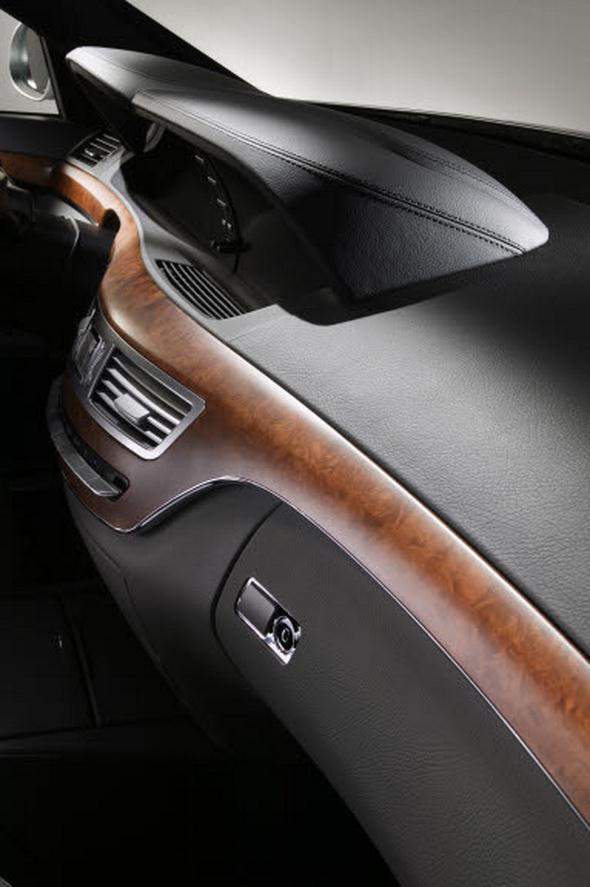
- At standstill the petrol engine is usually switched off, and therefore consumes no fuel. The electric drive of the refrigerant compressor and steering servo pump allows uninterrupted operation of the air conditioning and power steering. Comfort is in no way compromised, and is at the same high level as in all S-Class models. Even the partial vacuum required for brake servo assistance is generated electrically.
- Moving off and acceleratingaway gently remains a smooth and comfortable procedure. A driver who kicks down the accelerator for a brisk start benefits from the boost function of the electric motor, which produces considerably more dynamic acceleration.
- At cruising speed, the intelligent electronic management system detects the situation, for example a stretch of relaxed driving on a motorway, and automatically moves the load point of the petrol engine over to lower specific fuel consumption, thereby helping to save fuel and reduce emissions.
- When rolling to a stopthe recuperation function is activated as soon as the drive is interrupted in any way (foot off the accelerator, engine braking). Once the vehicle speed falls below 15 km/h, the petrol engine is automatically switched off.
- If the driver brakes using the brake pedal, the electric motor initially begins to convert the vehicle’s kinetic energy into electrical energy. In this case the electric motor acts as a generator, storing the kinetic energy as electrical energy in the lithium-ion battery. This process feels like an engine braking effect to the driver. The conventional disc brakes at the wheels are not yet employed. The disc brakes are only activated if the driver requires heavier deceleration, braking the car together with the engine brake and recuperation.
- Once the driver selects “R” (reverse) in the 7G-TRONIC automatic transmission when manoeuvring,‑this automatically activates the manoeuvring mode and prevents the ECO start/stop function from switching off the engine at short, frequent intervals.
- The advantages of the hybrid drive system really come into their own in city traffic, with frequent stops at red traffic lights. Already switching off the petrol engine as the car frequently coasts to a stop significantly lowers the fuel consumption and emissions, while the long recuperation phases increase the battery charge. The electric motor ensures particularly comfortable and rapid restarting when the ECO start/stop function is active.
- On rural roadsthere are frequent changes between boost, constant speed and recuperation phases. Depending on the nature of the route, large quantities of recuperation energy are available to reduce fuel consumption and emissions. The more braking and acceleration phases there are, the better: uphill and downhill gradients, as well as winding, dynamic stretches, make for the largest savings.
- The hybrid effect is inherently less important on motorways, however thanks to specific modifications to the V6 petrol engine and the 7G-TRONIC automatic transmission, the driver is also able to achieve significant fuel savings and correspondingly lower emissions on fast road stretches like these.

New engines for the S-Class

S 250 CDI ( W221 ) 2010
23 September 2010
The new standard for efficiency
With a total of four new diesel and petrol engines, the Mercedes-Benz S-Class defines the efficiency standard in its segment.
The accolade of “the world’s most economical luxury saloon” goes to the new S 250 CDI BlueEFFICIENCY. This high-tech turbodiesel is the first four-cylinder engine in the almost 60-year success story of the S-Class.
Developing an output of 150 kW (204 hp), the S 250 CDI BlueEFFICIENCY achieves a fuel consumption of just 5.7 litres per 100 kilometres (NEDC), corresponding to CO2 emissions of 149 grams per kilometre.
The likewise new V6 diesel in the S 350 BlueTEC delivers 190 kW (258 hp) and has a combined consumption of 6.8 litres per 100 kilometres (177 g CO2/km). Thanks to AdBlue® emission control, it is one of the world’s cleanest diesel engines.
With 225 kW (306 hp) in the S 350 BlueEFFICIENCY and 320 kW (435 hp) in the S 500 BlueEFFICIENCY, the new BlueDIRECT engine generation is now entering the lists in the form of V6 and V8 petrol variants.
“The new highly efficient petrol and diesel engines in the S-Class demonstrate that our customers are also able to drive a luxury class car with a clear conscience,” says Dr. Thomas Weber, the member of the Daimler AG Executive Board responsible for corporate research and development at Mercedes-Benz Cars.
“More than ever before, the luxury saloon combines the leadership claim of Mercedes-Benz with respect to efficient drive systems with the classic brand strengths in the realms of design, safety, comfort and effortlessly superior performance”.
All the diesel and petrol engines have direct injection
Mercedes-Benz achieves the considerable reduction in fuel consumption and improvement in efficiency with an intelligent combination of technical innovations that take effect throughout the entire powertrain: in addition to direct injection in the diesel engines, as well as in the new V6 and V8 BlueDIRECT petrol engines, these include the extensively revised, high-efficiency 7G-TRONIC PLUS 7-speed automatic transmission and the ECO start/stop function.
This high-tech package is supplemented with other specific BlueEFFICIENCY measures such as the load-controlled oil pump and tyres with lower rolling resistance.
The four-cylinder diesel in the S 250 CDI BlueEFFICIENCY is equipped with latest-generation common-rail direct injection.
The high rail pressure of 2000 bar enables output and torque figures at the level of a six-cylinder diesel to be achieved.
In the S 350 BlueEFFICIENCY and S 500 BlueEFFICIENCY, the newly developed BlueDIRECT technology package ensures a lower fuel consumption together with increased power.
The key factor is third-generation spray-guided direct petrol injection with multiple injection and multi-spark ignition. With the innovative V6 and V8 petrol units, Mercedes-Benz is founding a family of engines with a wide range of displacements and outputs.
This is based on a flexible, modular concept that allows the integration of turbochargers, and combination with 4MATIC all-wheel drive as well as hybrid modules.
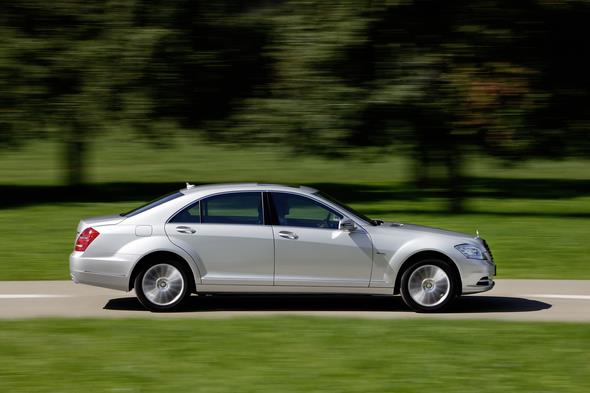
Fuel economy: ECO start/stop function
The excellent consumption and emission figures are also due to the new ECO start/stop function. This is standard equipment in the S 250 CDI BlueEFFICIENCY as well as the petrol-powered S 350 BlueEFFICIENCY and S 500 BlueEFFICIENCY models.
The ECO start/stop function switches the engine off as soon as the vehicle stops – for example at traffic lights – and the driver keeps the brake pedal depressed after coming to a halt.
The engine restarts immediately when the driver takes his foot from the brake pedal.
The ECO start/stop function will not switch the engine off if e.g. the desired interior temperature has yet to be reached, if the driver has switched off the system or if drive modes “S” or “M” are active.
An intelligent control system ensures that all functions and comfort systems otherwise remain in operation during the stop phase.

S 250 CDI BlueEFFICEINCY: first 5 litres/100 km car in the luxury segment
With the new S 250 CDI BlueEFFICIENCY, Mercedes-Benz is now launching the world’s most fuel-efficient luxury saloon.
The first four-cylinder engine in the more than 60-year success story of the S-Class attains a fuel consumption of just 5.7 litres per 100 kilometres, corresponding to CO2 emissions of 149 grammes per kilometre.
This makes the new S 250 CDI BlueEFFICIENCY the first car in the luxury segment to run on under 6 litres of fuel per 100 km, and the first vehicle in its class to attain CO2 emissions below the 150 gramme mark.
With a peak power output of 150 kW (204 hp) and maximum torque of 500 Newton metres, the four-cylinder CDI guarantees the superior performance which is a hallmark of the S-Class.
It accelerates the large saloon from 0 to 100 km/h in 8.2 seconds, and attains a top speed of 240 km/h.
The 2.2-litre CDI engine already delivers its maximum torque of 500 Nm at 1600 rpm. The high torque at low engine speeds is a result of two-stage turbocharging.
This technology, which is employed in a series-production passenger car diesel engine for the first time in the C and E-Class, is predominantly responsible for the high output at the level of a six-cylinder power unit.
The compact module for the two-stage turbocharger consists of a small high-pressure (HP) turbocharger and a large low-pressure (LP) turbocharger.
These are connected in series, and each has a turbine and a compressor driven by this turbine. The HP turbine is located directly at the exhaust manifold and initially allows exhaust gas to flow through it; it then rotates at up to 215,000 revolutions per minute.
The HP turbine housing features an integral bypass duct, which can be opened or closed by means of a charge-pressure control flap triggered by a vacuum cell.
If the flap is closed, the whole exhaust stream flows through the HP turbine, so that the exhaust-gas energy is available solely for the HP turbine drive. This means that the optimum charge pressure can be built up at low engine revs.
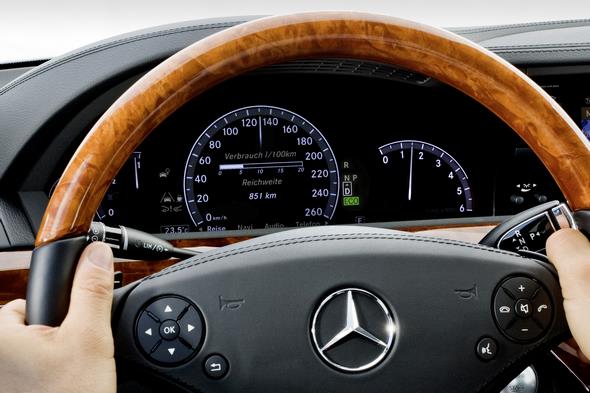
Improved cylinder charging even at low rpm
The two compressors are likewise connected in series, and are in addition connected to a bypass duct. The combustion air from the air filter first flows through the low-pressure compressor, where it is compressed as a function of the LP turbine’s output.
This pre-compressed air then passes into the high-pressure compressor, which is coupled to the HP turbine, where it undergoes further compression.
The result is a genuine two-stage turbocharging process. The major advantage of this sophisticated, demand-related control of the combustion air supply using two turbochargers is improved cylinder charging, and therefore high torque even at low engine speeds.
Fuel consumption is also reduced. When the car is driven, this concept makes itself felt by harmonious driving characteristics with no turbo-lag, a favourable torque curve across the entire engine speed range, great responsiveness and excellent performance.
Fourth-generation common rail technology
A further feature of the innovative and highly efficient diesel engine is fourth-generation common rail direct injection.
The rail pressure of 2000 bar is essential for the delivery of 150 kW (204 hp) of engine output and maximum torque of
500 Nm, while achieving low untreated emissions.

Dynamically controlled engine mounts dampen vibrations
To ensure hallmark S-Class comfort, dynamically controlled engine mounts feature as an innovation in the new S 250 CDI BlueEFFICIENCY.
The rigidity and damping of these mounts alter according to engine speed, load and vehicle speed, thus preventing the transmission of unwanted vibrations and noise from the engine to the body.
Key figures for the four-cylinder diesel engine
| Cylinder number/arrangement | 4/in-line |
| Displacement (cc) | 2143 |
| Bore (mm) | 83 |
| Stroke (mm) | 99 |
| Compression ratio | 16.2 : 1 |
| Output (kW at rpm) | 150 at 4200 rpm |
| Torque (Nm at rpm) | 500 at 1600-1800 rpm |
S 350 BlueTEC: highly efficient, clean, powerful
The second new diesel model in the S-Class is the S 350 BlueTEC. Its V6 develops an output of 190 kW (258 hp) from a displacement of 2987 cc.
This is ten percent more than the previous model, which delivered 173 kW (235 hp). The torque of the V6 diesel has increased by 15 percent from 540 to 620 newton metres.
Despite much improved performance, with a combined consumption of 6.8 litres of diesel fuel per 100 kilometres the S 350 BlueTEC betters its predecessor by 0.8 litres or eleven percent.
CO2 emissions have likewise fallen by eleven percent, from 199 to 177 grams per kilometre. The highly efficient V6 diesel gives the luxury saloon effortlessly superior performance: it sprints from zero to 100 km/h in 7.1 seconds and has a top speed of 250 km/h.
Moreover, the S 350 BlueTEC ranks among the world’s cleanest diesel models: BlueTEC is a technology developed by Mercedes-Benz to reduce emissions from diesel vehicles, in particular nitrogen oxides.
To this end AdBlue®, an aqueous urea solution, is injected into the exhaust flow. This releases ammonia, which converts up to 80 percent of nitrogen oxides into harmless nitrogen and water in the downstream SCR (Selective Catalytic Reduction) catalytic converter.
As a result, the S 350 BlueTEC already complies with the emission levels which are planned for 2014 with the introduction of the EU6 standard.
The AdBlue® tank is installed under the boot floor and has a capacity of 25.7 litres. The supply is replenished at the regular maintenance intervals, every 25,000 kilometres.
Key figures for the new V6 diesel engine
| Cylinder arrangement/number | V6 |
| Displacement (cc) | 2987 |
| Bore (mm) | 83 |
| Stroke (mm) | 92 |
| Compression ratio | 15.5:1 |
| Output (kW at rpm) | 190 at 3600 |
| Torque (Nm at rpm) | 620 at 1600-2400 rpm |

BlueDIRECT technology makes V6 and V8 engines fit for the future
With the two BlueDIRECT power plants of the S 350 BlueEFFICIENCY and S 500 BlueEFFICIENCY, Mercedes-Benz is once again raising the bar when it comes to efficiency in the luxury saloon segment.
They are representatives of a new generation of BlueDIRECT V6 and V8 engines.
With its new generation V-engines, Mercedes-Benz is clearly demonstrating that with concerted further development, internal combustion engines still have a great deal of potential, and that V6 and V8 engines with their high level of refinement also have a future.
Centrepiece of the BlueDIRECT technology package is the improved third-generation direct petrol injection with spray-guided combustion and piezo injectors.
In combination with multi-spark ignition it taps further possibilities for improving consumption – in the V8 unit through a further developed homogeneous combustion process (“homogeneous split”); in the V6 engine through a new stratified combustion method with a much larger useful engine characteristic map and lean-burn combustion for optimum consumption (“homogeneous stratified mode”).
As the name indicates, the HOS method is a combination of homogeneous-lean and conventional stratified combustion. The first injection takes place during the intake stroke so that a homogeneous base mixture is formed.
The “stratified” injection proper takes place during the compression stroke prior to ignition, as map-controlled single or double injection.
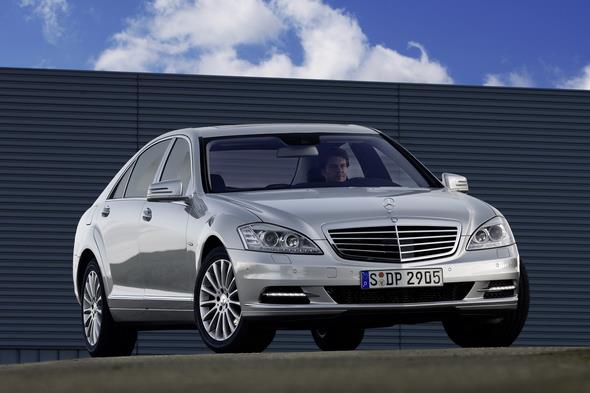
Multi-spark ignition: best possible ignition to suit requirements
The third-generation direct injection system also features rapid multi-spark ignition (MSI). Following the first spark discharge and a brief combustion period, the coil is rapidly recharged and a further spark is discharged.
The MSI system enables up to four sparks to be discharged in rapid succession within one millisecond, creating a plasma with a larger spatial expansion than conventional ignition.
Controlling this rapid multi-spark ignition enables both the time lapse before the next spark and the combustion duration for the relevant operating point to be optimally adjusted.
This provides scope for optimising the centre of combustion and improving residual gas compatibility, especially during stratified charge operation. Fuel consumption can be reduced by roughly two percent in this way.
Depending on the driving cycle, fuel savings of up to four percent are possible alone by the use of piezo-electric injection technology in combination with multi-spark ignition.
S 350 BlueEFFICIENCY: up to 24 percent lower consumption
The ultra-modern 3.5-litre V6 engine of the S 350 BlueEFFICIENCY and S 350 4MATIC BlueEFFICIENCY is naturally aspirated, but also suitable for the future use of a turbocharger thanks to the modular design concept.
The most striking change between the new V6 unit and its predecessor is a reduction in the V-angle between the cylinder banks from 90 degrees to 60 degrees.
This enables the primary balancer shaft to be omitted, and as a result the driver registers an outstanding level of comfort.
The design highlights of the 3.5-litre V6 include a completely new air intake and exhaust system in conjunction with a variable resonance intake manifold and optimised inflow and outflow.
Result: with the same displacement, the output compared with the previous 200 kW (272 hp) model is increased by 12.5 percent to 225 kW (306 hp), while maximum torque has increased by 5.7 percent to 370 Newton metres (predecessor: 350 Nm) and now is available over a broad engine speed range from 3500 to 5250 rpm.
In parallel with this substantial increase in power, Mercedes engineers have achieved an even more impressive reduction in fuel consumption.
The predecessor’s NEDC consumption was already good at 10.0 litres of premium petrol per 100 kilometres, but has now been cut by almost a quarter.
The new V6 petrol engine in the S 350 BlueEFFICIENCY is content with 7.6 litres per 100 kilometres. That adds up to savings of 2.4 litres or 24 percent, and makes the S 350 BlueEFFICIENCY the most economical petrol model in the luxury class.
CO2 emissions have also fallen by 24 percent – from 234 to 177 grams per kilometre (short wheelbase) and by 23.5 percent to 179 grams per kilometre (long wheelbase). The S 350 BlueEFFICIENCY combines excellent consumption figures with dynamic performance, accelerating from standstill to 100 km/h in 6.9 seconds. Top speed is 250 km/h (electronically limited).
Key figures for the new V6 petrol engine
| Cylinder arrangement/number | V6 |
| Displacement (cc) | 3498 |
| Bore (mm) | 92.9 |
| Stroke (mm) | 86 |
| Compression ratio | 12.2:1 |
| Output (kW at rpm) | 225 at 6500 |
| Torque (Nm at rpm) | 370 at 3500-5250 rpm |

S 500 BlueEFFICIENCY: more powerful, more economical, more efficient
The new V8 biturbo engine in the S 500 BlueEFFICIENCY and S 500 4MATIC BlueEFFICIENCY generates 320 kW (435 hp) with 15 percent less displacement (4663 instead of 5461 cc), and therefore around twelve percent more output than its 285 kW (388 hp) predecessor.
Torque has risen from 530 to 700 newton metres – an increase of 32 percent.
Despite a considerable increase in power of 35 kW (47 hp), Mercedes developers have been able to reduce the combined fuel consumption of the S 500 BlueEFFICIENCY significantly.
At 9.3 litres of premium petrol per 100 kilometres, this is 15.5 percent (short wheelbase) and 16 percent (long wheelbase) below the figure for the preceding model.
An outstanding figure in the luxury class, this corresponds to CO2 emissions of 219 grams per kilometre. The excellent efficiency goes hand in hand with superior performance: the S 500 BlueEFFICIENCY sprints from zero to 100 km/h in impressive 5.0 seconds.
Top speed is 250 km/h (electronically limited). The increase in output and torque despite the reduced displacement is mainly due to the use of two turbochargers – one for each bank of cylinders.
These force the intake air into the eight combustion chambers at a pressure of up to 0.9. The turbochargers are configured to provide a high torque at low engine speeds, and an outstanding 600 newton metres are already available between 1600 and 4750 rpm.
Key figures for the new V8 biturbo engine
| Cylinder arrangement/number | V8 |
| Displacement (cc) | 4663 |
| Bore (mm) | 92.9 |
| Stroke (mm) | 86 |
| Compression ratio | 10.5:1 |
| Output (kW at rpm) | 320 at 5250 |
| Torque (Nm at rpm) | 700 at 1800-3500 rpm |
The S 600, with its 380 kW (517 hp) 12-cylinder biturbo engine remains the top-of-the-line model: it accelerates the luxury saloon from a standstill to 100 km/h in impressive 4.6 seconds, and now also complies with the Euro 5 emission standard.
More efficiency thanks to demand-controlled ancillary units
In order to improve efficiency, Mercedes-Benz developers have also reduced the power consumption of the ancillary units for the new petrol and diesel engines. One of these is a newly developed, controlled oil pump.
This operates at two pressure levels. At low engine speeds and loads the pump runs at a low pressure. The high-pressure stage is activated at the upper load and engine speed levels.
Thanks to this innovative control concept, the lubrication and cooling points of the engine can be supplied with significantly lower drive energy than would be possible with an uncontrolled pump. In this way, the developers have particularly managed to lower fuel consumption in driving modes requiring less power, for example in urban traffic.
Another special feature is the switchable water pump. To enable faster engine warm-up, the pump is not activated until the optimum operating temperature is reached. This also contributes to the reduction in fuel consumption.
In the S 350 BlueEFFICIENCY and S 500 BlueEFFICIENCY, there is also intelligent generator management with braking energy recuperation.
Designed for maximum efficiency: the new 7G-TRONIC PLUS
All four new engines are combined with the new 7G-TRONIC PLUS 7-speed automatic transmission, which brings a further reduction in torque converter slip and optimised efficiency.
A central role is played by the new torsion damper, which eliminates torsional eccentricities and vibrations in the transmission.
The lower the rpm and the lower the number of cylinders, the more severe these can be. This results in a conflict of aims between comfort and fuel-efficient operation. Mercedes-Benz developers resolved this by using a so-called twin-turbine damper, which is also fitted with a centrifugal pendulum.
Depending on the rpm, this moves the centre of mass and allows comfortable operation even in the most economical operating range.
The optimised damping allows a marked reduction in the slip of the torque converter lockup clutch even under low loads. In the fuel-efficient ECO transmission mode, this has enabled engine speeds to be lowered without compromising signature S-Class comfort.
In addition, the optimised damping of rotational irregularities and vibrations in the transmission allows an even faster response to driver commands via the accelerator pedal.
The S 350 BlueTEC is already in the showrooms of Mercedes-Benz own-retail outlets and dealerships. The S-Class with the new BlueDIRECT petrol engines and the S 250 CDI BlueEFFICIENCY can be ordered with immediate effect.
- S 250 CDI BlueEFFICIENCY Euro 71,876*
- S 350 BlueTEC Euro 76,279*
- S 350 BlueEFFICIENCY Euro 78,718*
- S 500 BlueEFFICIENCY Euro 99,186*
- S 600 Euro 156,961
All prices include 19 % VAT.
* for short-wheelbase model; S600 standard as long wheelbase version
Mercedes-Benz S 250 CDI BlueEFFICIENCY
Engine
| Number of cylinders/arrangement | 4/in-line, 4 valves per cylinder | |
| Displacement | cc | 2143 |
| Bore x stroke | mm | 83 x 99 |
| Rated output | kW (hp) | 150 (204) at 4200 rpm |
| Rated torque | Nm | 500 at 1600-1800 rpm |
| Compression ratio | 16.2 : 1 | |
| Mixture formation | High-pressure fuel injection with common-rail technology, two-stage turbocharger, EDC |
Power transmission
| Drive system | Standard drive system | |
| Transmission | 7-speed automatic transmission | |
| Ratios | Final drive 1st gear 2nd gear 3rd gear 4th gear 5th gear 6th gear 7th gear Reverse | 2.823 4.377 2.859 1.921 1.368 1.000 0.820 0.728 –3.416/–2.231 |
Chassis and suspension
| Front axle | Four-link suspension, anti-dive control, AIRMATIC air suspension, gas-filled shock absorbers, stabiliser |
| Rear axle | Multi-link independent suspension, anti-squat and anti-dive, AIRMATIC air suspension, gas-filled shock absorbers, stabiliser |
| Braking system | Disc brakes all-round, front internally ventilated, drum-type parking brake at rear, ABS, Brake Assist, ESP® |
| Steering | Rack-and-pinion with speed-sensitive power assistance, steering damper |
| Wheels | 8 J x 17 ET 43 |
| Tyres | 235/55 R 17 |
Dimensions and weights
| Short wheelbase | Long wheelbase | ||
| Wheelbase | mm | 3035 | 3165 |
| Track, front/rear | mm | 1600/1606 | 1600/1606 |
| Overall length | mm | 5096 | 5226 |
| Overall width | mm | 1871 | 1871 |
| Overall height | mm | 1479 | 1479 |
| Turning circle | m | 11.8 | 11.8 |
| Boot capacity* | l | 560 | 560 |
| Kerb weight (EC)** | kg | 1970 | 2045 |
| Payload (basis: ready-to-drive state as defined by EC) | kg | 595 | 560 |
| Perm. GVW | kg | 2565 | 2605 |
| Tank capacity/incl. reserve | l | 83/11 | 83/11 |
Performance and fuel consumption
| Acceleration 0 – 100 km/h | s | 8.2 | 8.2 |
| Top speed | km/h | 240 | 240 |
| Fuel consumption*** | l/100 km | 5.7 – 5.8 | 5.7 – 5.8 |
| CO2 emissions | g/km | 149-151 | 149-151 |
*acc. to VDA measuring method; ** incl. 75 kg for driver and luggage; *** combined
Mercedes-Benz S 350 BlueTEC
Engine
| Number of cylinders/arrangement | 6/V, 4 valves per cylinder | |
| Displacement | cc | 2987 |
| Bore x stroke | mm | 83 x 92 |
| Rated output | kW (hp) | 190 (258) at 3600 rpm |
| Rated torque | Nm | 620 at 1600-2400 rpm |
| Compression ratio | 15.5:1 | |
| Mixture formation | Common-rail direct injection, turbocharger, EDC |
Power transmission
| Drive system | Standard drive system | |
| Transmission | 7-speed automatic transmission | |
| Ratios | Final drive 1st gear 2nd gear 3rd gear 4th gear 5th gear 6th gear 7th gear Reverse | 2.65 4.377 2.859 1.921 1.368 1.000 0.820 0.728 –3.416/–2.231 |
Chassis and suspension
| Front axle | Four-link suspension, anti-dive control, AIRMATIC air suspension, gas-filled shock absorbers, stabiliser |
| Rear axle | Multi-link independent suspension, anti-squat and anti-dive, AIRMATIC air suspension, gas-filled shock absorbers, stabiliser |
| Braking system | Disc brakes all-round, front internally ventilated, drum-type parking brake at rear, ABS, Brake Assist, ESP® |
| Steering | Rack-and-pinion with speed-sensitive power assistance, steering damper |
| Wheels | 8 J x 17 ET 43 |
| Tyres | 235/55 R 17 |
Dimensions and weights
| Short wheelbase | |||
| Wheelbase | mm | 3035 | |
| Track, front/rear | mm | 1600/1606 | |
| Overall length | mm | 5096 | |
| Overall width | mm | 1871 | |
| Overall height | mm | 1479 | |
| Turning circle | m | 11.8 | |
| Boot capacity* | l | 560 | |
| Kerb weight (EC)** | kg | 1995 | |
| Payload (basis: ready-to-drive state as defined by EC) | kg | 595 | |
| Perm. GVW | kg | 2590 | |
| Tank capacity/incl. reserve | l | 83/11 |
Performance and fuel consumption
| Acceleration 0 – 100 km/h | s | 7.1 | |
| Top speed | km/h | 250 | |
| Fuel consumption*** | l/100 km | 6.8 | |
| CO2 emissions | g/km | 177-182 |
*acc. to VDA measuring method; ** incl. 75 kg for driver and luggage; *** combined
Mercedes-Benz S 350 BlueEFFICIENCY
Engine
| Number of cylinders/arrangement | 6/V, 4 valves per cylinder | |
| Displacement | cc | 3498 |
| Bore x stroke | mm | 92.9 x 86 |
| Rated output | kW (hp) | 225 (306) at 6500 rpm |
| Rated torque | Nm | 370 at 3500-5250 rpm |
| Compression ratio | 12.2:1 | |
| Mixture formation | Microprocessor-controlled injection system with hot-film air-mass sensor (HFM) |
Power transmission
| Drive system | Standard drive system | |
| Transmission | 7-speed automatic transmission | |
| Ratios | Final drive 1st gear 2nd gear 3rd gear 4th gear 5th gear 6th gear 7th gear Reverse | 3.07 4.377 2.859 1.921 1.368 1.000 0.820 0.728 –3.416/–2.231 |
Chassis and suspension
| Front axle | Four-link suspension, anti-dive control, AIRMATIC air suspension, gas-filled shock absorbers, stabiliser |
| Rear axle | Multi-link independent suspension, anti-squat and anti-dive, AIRMATIC air suspension, gas-filled shock absorbers, stabiliser |
| Braking system | Disc brakes all-round, front internally ventilated, drum-type parking brake at rear, ABS, Brake Assist, ESP® |
| Steering | Rack-and-pinion with speed-sensitive power assistance, steering damper |
| Wheels | 8 J x 17 ET 43 |
| Tyres | 235/55 R 17 |
Dimensions and weights
| Short wheelbase | Long wheelbase | ||
| Wheelbase | mm | 3035 | 3165 |
| Track, front/rear | mm | 1600/1606 | 1600/1606 |
| Overall length | mm | 5096 | 5226 |
| Overall width | mm | 1871 | 1871 |
| Overall height | mm | 1479 | 1479 |
| Turning circle | m | 11.8 | 12.2 |
| Boot capacity* | l | 560 | 560 |
| Kerb weight (EC)** | kg | 1910 | 1975 |
| Payload (basis: ready-to-drive state as defined by EC) | kg | 595 | 580 |
| Perm. GVW | kg | 2505 | 2555 |
| Tank capacity/incl. reserve | l | 83/11 | 83/11 |
Performance and fuel consumption
| Acceleration 0 – 100 km/h | s | 6.9 | 6.9 |
| Top speed | km/h | 250 | 250 |
| Fuel consumption*** | l/100 km | 7.6-7.9 | 7.7-8.0 |
| CO2 emissions | g/km | 177-184 | 179-186 |
*acc. to VDA measuring method; ** incl. 75 kg for driver and luggage; *** combined
Mercedes-Benz S 500 BlueEFFICIENCY
Engine
| Number of cylinders/arrangement | 8/V, 4 valves per cylinder | |
| Displacement | cc | 4663 |
| Bore x stroke | mm | 92.9 x 86 |
| Rated output | kW (hp) | 320 (435) at 5250 rpm |
| Rated torque | Nm | 700 at 1800-3500 rpm |
| Compression ratio | 10.5:1 | |
| Mixture formation | Microprocessor-controlled direct petrol injection with direct-control 180-bar injectors, biturbo system |
Power transmission
| Drive system | Standard drive system | |
| Transmission | 7-speed automatic transmission | |
| Ratios | Final drive 1st gear 2nd gear 3rd gear 4th gear 5th gear 6th gear 7th gear Reverse | 2.65 4.377 2.859 1.921 1.368 1.000 0.820 0.728 –3.416/–2.231 |
Chassis and suspension
| Front axle | Four-link suspension, anti-dive control, AIRMATIC air suspension, gas-filled shock absorbers, stabiliser |
| Rear axle | Multi-link independent suspension, anti-squat and anti-dive, AIRMATIC air suspension, gas-filled shock absorbers, stabiliser |
| Braking system | Disc brakes all-round, front and rear internally ventilated, front perforated, drum-type parking brake at rear, ABS, Brake Assist, ESP® |
| Steering | Rack-and-pinion with speed-sensitive power assistance, steering damper |
| Wheels | 8.5 J x 18 ET 43 |
| Tyres | 255/45 R 18 |
Dimensions and weights
| Short wheelbase | Long wheelbase | ||||||
| Wheelbase | mm | 3035 | 3165 | ||||
| Track, front/rear | mm | 1600/1606 | 1600/1606 | ||||
| Overall length | mm | 5096 | 5226 | ||||
| Overall width | mm | 1871 | 1871 | ||||
| Overall height | mm | 1479 | 1479 | ||||
| Turning circle | m | 11.8 | 12.2 | ||||
| Boot capacity* | l | 560 | 560 | ||||
| Kerb weight (EC)** | kg | 2010 | 2070 | ||||
| Payload (basis: ready-to-drive state as defined by EC) | kg | 605 | 580 | ||||
| Perm. GVW | kg | 2615 | 2655 | ||||
| Tank capacity/incl. reserve | l | 90/11 | 83/11 | ||||
Performance and fuel consumption
| Acceleration 0 – 100 km/h | s | 5.0 | 5.0 |
| Top speed | km/h | 250 | 250 |
| Fuel consumption*** | l/100 km | 9.3-9.6 | 9.3-9.6 |
| CO2 emissions | g/km | 219-224 | 219-224 |
*acc. to VDA measuring method; ** incl. 75 kg for driver and luggage; *** combined






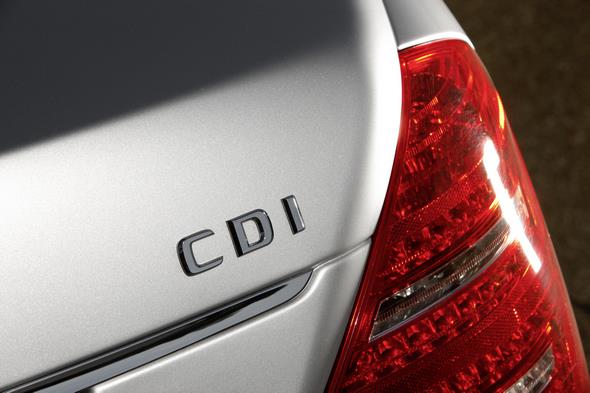
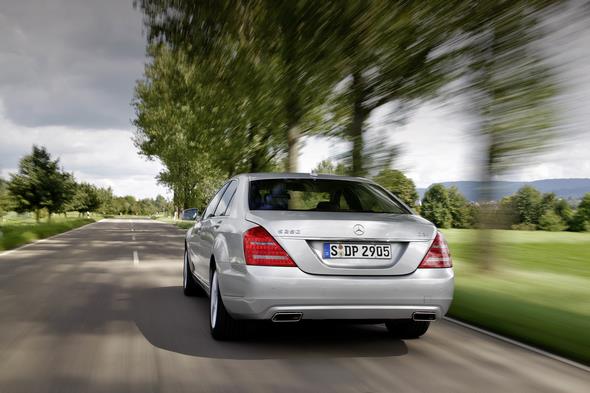
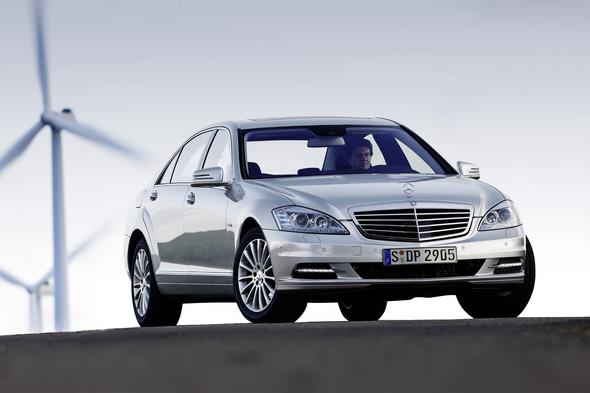












































































































































































![2150088502_3e9e867619_o[1] 2150088502_3e9e867619_o[1]](/wp-content/gallery/w221/thumbs/thumbs_2150088502_3e9e867619_o%5B1%5D.jpg)
![2150088678_a1229f50a1_o[1] 2150088678_a1229f50a1_o[1]](/wp-content/gallery/w221/thumbs/thumbs_2150088678_a1229f50a1_o%5B1%5D.jpg)
















































































































































































































































































































